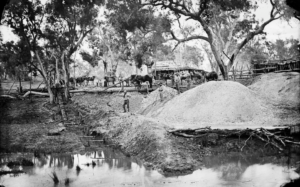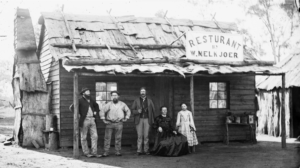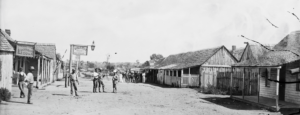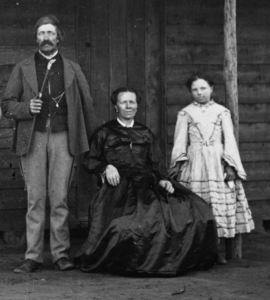A number of photos in the Holtermann collection have not been identified. Some are attributed to Gulgong or Home Rule but captioned by the State Library with an additional question mark. This week I set out to solve one of those mysteries.
 When you look at many of the images of mining equipment among piles of dirt and forest it’s hard to imagine how anyone could identify anything that could be pinned to a specific location.
When you look at many of the images of mining equipment among piles of dirt and forest it’s hard to imagine how anyone could identify anything that could be pinned to a specific location.
But if you look closely you can see that the hut in the centre of this image has a sign above the verandah and it just so happens that there is another photo of this same hut where the sign is even clearer. It reads “RESTURANT by W. MELKJOER”. What a fantastic clue! I just needed to look up Trove (the National Library’s archive of digitised newspapers) and read all the articles about Melkjoer’s restaurant to find the location.
And that’s where I hit a problem. There was not a single hit for “Melkjoer” across all the digitised newspapers of Australia. Not one! I also tried “Melk Joer” in case it was two words. Nothing. That’s OK. Trove is not the only tool in my research belt. I went on to search every State archive for the surname. I tried Births, Deaths and Marriage records. Yes, I even tried a plain old Google search in my desperation. The only hits for “Melkjoer” were a few websites that host these photos.
 I decided to crowdsource my problem and so asked a family history Facebook group what else I could try. In no time, someone came up with a similar name, “Malkior”, for a family located in Wellington at around the same time. I had considered the possibility of alternate spelling but only of the last syllable. All my guesses started with “melk” which, in many languages, translates as “milk”. Further help from Google Translate suggested that if the family was from Denmark, the sign actually says “RESTURANT by MILKCOW”. Perhaps that’s reason enough to alter the spelling of your surname! And yes, it’s clear they couldn’t spell “restaurant” either, but that’s just the start of my spelling troubles with this family.
I decided to crowdsource my problem and so asked a family history Facebook group what else I could try. In no time, someone came up with a similar name, “Malkior”, for a family located in Wellington at around the same time. I had considered the possibility of alternate spelling but only of the last syllable. All my guesses started with “melk” which, in many languages, translates as “milk”. Further help from Google Translate suggested that if the family was from Denmark, the sign actually says “RESTURANT by MILKCOW”. Perhaps that’s reason enough to alter the spelling of your surname! And yes, it’s clear they couldn’t spell “restaurant” either, but that’s just the start of my spelling troubles with this family.
I repeated the searches listed above with the new spelling, “Malkior”, and discovered a number of helpful – and not so helpful – things. William Malkior was a native of Denmark. He married a Danish woman called “Marion Cristena” also listed as “Maria Christina” or even just “Christenier”.
 William bought land at “Omigal” (which doesn’t exist any more). His block of land was on the corner of Wellington and Sibthorp Streets. But Sibthorp Street doesn’t exist now either. Omigal had been a village in the Parish of Ironbarks at the Stony Creek and Ironbark Gold Fields, County of Wellington. It was near today’s Stuart Town (pictured here in the early 1870s). One of the children was born at Farnham (also known as Stony Creek). So I was dealing with a dubiously spelt surname, multiple options for the mother’s name and now another location I’d never heard of! But thankfully Farnham was also in the vicinity of the once-existing Omigal so I persevered.
William bought land at “Omigal” (which doesn’t exist any more). His block of land was on the corner of Wellington and Sibthorp Streets. But Sibthorp Street doesn’t exist now either. Omigal had been a village in the Parish of Ironbarks at the Stony Creek and Ironbark Gold Fields, County of Wellington. It was near today’s Stuart Town (pictured here in the early 1870s). One of the children was born at Farnham (also known as Stony Creek). So I was dealing with a dubiously spelt surname, multiple options for the mother’s name and now another location I’d never heard of! But thankfully Farnham was also in the vicinity of the once-existing Omigal so I persevered.
The most helpful discovery on Trove was this death notice:
1885 – MALKIOR. March 18, at Newrea, Christenier, the beloved wife of William Malkior, hotel keeper, and mother to J. P. Malkior and Mrs. Andrew Bell, of Newrea, after a long and suffering illness, which she bore with Christian fortitude, aged 59 years.
Source: Australian Town and Country Journal Sat 4 Apr 1885 Page 43
 I worked backwards from this to find the children’s names were James Peter and Willhelmena. Two other children born in Australia had died in infancy.
I worked backwards from this to find the children’s names were James Peter and Willhelmena. Two other children born in Australia had died in infancy.Fascinating as all this may be, I had not yet proven whether this multiply-spelled family near Wellington had any link to the “Melkjoers” who were photographed on the Gulgong Goldfield in 1872. It is certainly plausible that a family from a goldfield near Wellington would join people from all over the world in hastening to Gulgong for the rush of the early 70s but I needed proof that they were here.
Photo sources:
- Gold sluicing machine running into river and tailings, with Melkjoer’s Restaurant, Mitchell Library, SLNSW
- W. Melkjoer’s restaurant, Mitchell Library, SLNSW
- Ironbarks, N.S.W. (later named Stuart Town), Mitchell Library, SLNSW
-
Detail of restaurant photo (above) depicting William, Cristena and Willhelmena Malkior.Click on the links to view the original high-resolution images via the State Library website.

